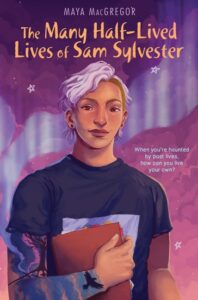Reviewed by Deborah Jung
Review Source: Teaching for Change
Book Author: Maya MacGregor
The Many Half-Lived Lives of Sam Sylvester is an original and heartfelt, if occasionally uneven, paranormal mystery centered around a close-knit friend group of LGBT+ teens. Sam has always collected stories of other teenagers who died before their nineteenth birthdays and occasionally experiences visions of the deceased teens’ memories. After nearly dying at the hands of homophobic bullies, Sam and their adopted father, Junius, move to a sleepy small town in Oregon hoping for a fresh start. Sam is relieved to discover that queer and autistic students like them are both accepted and supported at their new school. They befriend other LGBT+ peers for the first time and eventually develop a romantic interest in their new friend Shep. However, Sam also learns that their new house happens to be the site of a thirty-year-old cold case murder, which killed one of the teens from their research. When they attempt to investigate the murder, Sam and their friends uncover decades-old secrets and must decide who to trust in a small town where anyone could be a suspect.
Sam Sylvester deserves props for its head-on approach to representation and its integration of these social identities into its story. Queer characters of different genders and racial identities play prominent roles in the novel, a divergence from the unfortunately common practice of placing one or two LGBT+ characters into minor roles for shallow representation. Further, Sam is nonbinary and on the asexual spectrum, which are two LGBT+ identities that tend to be explored less in fiction, and rarely in a main character. It’s important for books and other media to have diverse, non-tokenistic characters in all genres, so I also enjoyed the book’s paranormal mystery premise. The novel achieves a balance of telling a story not directly related to the queer or neurodivergent identities of its characters, while still realistically representing the impact that these identities have on these characters’ lives.
Outside of its murder mystery plot, the story tackles many issues relevant to LGBT+ teens, such as hate crimes, biphobia, changing one’s gender presentation, and allyship. Some topics are less seamlessly integrated than others, but the book includes thoughtful commentary on these issues. As a warning for readers, the book depicts a homophobic attempted murder, which may be disturbing. The novel also depicts everyday barriers faced by autistic people, such as sensory overload and miscommunication with neurotypical peers.
Although I cannot vouch for the accuracy of these depictions personally since I am not LGBT+ or autistic, I appreciated that the story steered clear from stereotypical depictions of people with autism as white cishet male savants, as well as going beyond standard “coming out” narratives or tragic depictions of LGBT+ suffering. Maya MacGregor, the book’s author, is both nonbinary and autistic like Sam and presumably drew on many of their personal experiences to realistically portray Sam’s character. It would have been nice to know the perspectives of non-white, LGBT+ characters like Shep and Mr. Quach about how their racial and cultural identities relate to their sexual orientation, but as a white author, MacGregor may have not felt like they would have been able to realistically portray this theme.
The book also features a heartfelt approach to community and finding one’s family beyond biological relations. Sam is an adopted former foster child who is white and looks nothing like their Black adoptive father Junius. However, Sam and Junius’ relationship forms the emotional center of the book. Additionally, the book raises the importance of community and friendship, especially among LGBT+ teens and allies. While the story does not shy away from depicting challenges faced by LGBT+ students, it also centers the joy that there is to be found, especially by forming powerful friendships.
While the novel features well-done representation and strong themes, I am less enthusiastic about how the mystery plot was written. The middle of the book slows down, and the story doesn’t pick up the pace until the last quarter. Sam and their friends Shep and Sky don’t seem to discover many new clues until much closer to the end, which feels rushed in contrast to the slow middle section. In the end, I was surprised by the reveal of the killer’s identity, but MacGregor missed opportunities to add more twists, and the required red herrings and alternate suspects didn’t seem terribly convincing.
I also had issues with some of the dialogue and writing style. In the beginning of the book especially, characters tend to state chunks of information in dialogue to provide background to the story, which comes off as stilted and less subtle than simply letting Sam come to these conclusions through their own experiences and observations. While some of the book’s numerous pop-culture references are integrated well into the story, others stick out as awkward and unnecessary. It seems unrealistic, for example, for teen characters to continuously describe their feelings as emojis or compare their choices to a popular Tumblr gif. At times, the writing and Sam’s internal narrative can also come off as a bit choppy.
While Sam Sylvester may have issues with its pacing and dialogue, the book centers around a diverse cast of LGBT+ teen characters, contains important representation of tough issues, and places a heartfelt emphasis on community.
Deborah Jung is an intern with Teaching for Change for Summer 2023. She is a rising senior at Dartmouth College, where she is majoring in sociology and minoring in history.
[book-info}

Leave a Reply